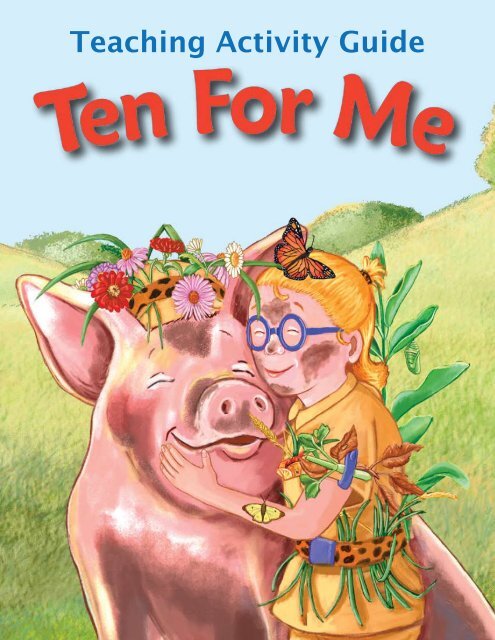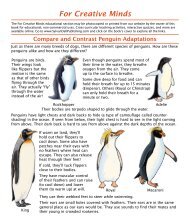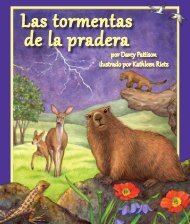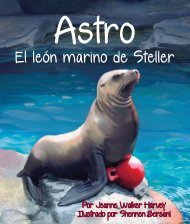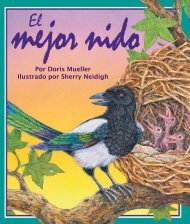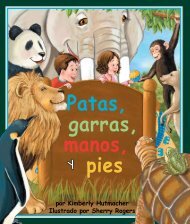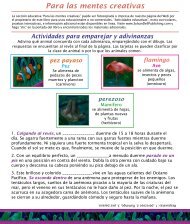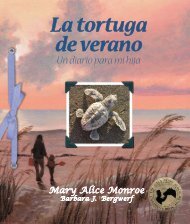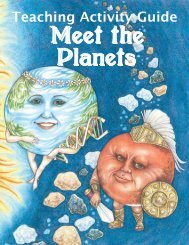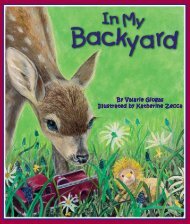Teaching Activity Guide - Sylvan Dell Publishing
Teaching Activity Guide - Sylvan Dell Publishing
Teaching Activity Guide - Sylvan Dell Publishing
You also want an ePaper? Increase the reach of your titles
YUMPU automatically turns print PDFs into web optimized ePapers that Google loves.
Table of Contents3 How to Use This <strong>Activity</strong> <strong>Guide</strong> (General)6 What Do Children Already Know?6 Pre-Reading Questions7 Comprehension & Writing Prompts8 Language Arts & Science: Five Senses8 Observation Skills: Art Scavenger Hunt9 Language Arts: Vocabulary Game9 Cross-Curricular: Using the Words10 Cross Curricular: Silly Sentences11 Word List (by parts of speech)12 Word Search13 Compare/Contrast Butterflies24 Science Journal26 True or False?27 Tens Make Friends28 Math Cards29 Coloring Pages31 Glossary39 Answers41 Appendix A—“What Children Know” Cards42 Appendix B—Venn Diagram43 Appendix C—U.S. Map44 Appendix D—North America MapCopyright 2011 © <strong>Sylvan</strong> <strong>Dell</strong> <strong>Publishing</strong>These activities may be copied forpersonal and non-commercial use ineducational settings.www.<strong>Sylvan</strong><strong>Dell</strong><strong>Publishing</strong>.com<strong>Sylvan</strong> <strong>Dell</strong> <strong>Publishing</strong>Mt. Pleasant, SC 29464by Barbara Maricondaillustrated by Sherry Rogers
Glossary/Vocabulary words: Word cards may be used (see Appendix) orhave children write on index cards, a poster board, or on a chalkboard for a“word wall.” If writing on poster board or chalkboard, you might want to sortwords into nouns, verbs, etc. right away to save a step later if using for SillySentences. Leaving the words posted (even on a refrigerator at home) allowsthe children to see and think about them frequently. The glossary has somehigh-level words. Feel free to use only those words as fit your situation.Silly Sentence Structure <strong>Activity</strong>: Game develops both an understanding ofsentence structure and the science subject. Use words from the “word wall” tofill in the blanks. After completing silly sentences for fun, have children try tofill in the proper words by looking for the information in the book.Animal Card Games:Sorting: Depending on the age of the children, have them sort cards by:where the animals live (habitat)tail, no tailnumber of legs (if the animals have legs) colors or skin patternshow they move (walk, swim, jump, or fly) animal classtype of skin covering (hair/fur, feathers, scales, moist skin)what they eat (plant eaters/herbivores, meat eaters/carnivores, both/omnivores)Memory Card Game: Make two copies of each of the sorting card pages andcut out the cards. Mix them up and place them face down on a table. Takingturns, each player should turn over two cards so that everyone can see. If thecards match, he or she keeps the pair and takes another turn. If they do notmatch, the player should turn the cards back over and it is another player’sturn. The player with the most pairs at the end of the game wins.Who Am I? Copy and cut out the cards. Poke a hole through each one and tieonto a piece of yarn. Have each child put on a “card necklace” without lookingat it so the card hangs down the back. The children get to ask each personone “yes/no” question to try to guess “what they are.” If a child answering thequestion does not know the answer, they should say they don’t know. This isa great group activity and a great “ice-breaker” for children who don’t reallyknow each other.Charades: One child selects a card and must act out what the animal is so thatthe other children can guess. The actor may not speak but can move like theanimal, can imitate body parts or behaviors. For very young children, you mightlet them make the animal sound. The child who guesses the animal becomesthe next actor.<strong>Sylvan</strong> <strong>Dell</strong> <strong>Publishing</strong> 4
Math Card Games (Make four copies of the math cards to play these games):Tens Make Friends Memory Game is a combination of a memory and addinggame.• Play like the memory game, above.• If the animal numbers add up to 10, the child keeps the pair and takesanother turn.• If they do not add up to ten, the player should turn the cards back over andit is another player’s turn.Go Fish for Fact Families is a twist on “Go Fish.”• Shuffle cards and deal five cards to each player. Put the remaining cardsface down in a draw pile.• If the player has three cards that make a fact family, he/she places themon the table and recites the four facts related to the family. For example, ifsomeone has a 2, 3, and 5, the facts are: 2 + 3 = 5, 3 + 2 = 5, 5 – 2 = 3, 5 –3 = 2.• The player then asks another player for a specific card rank. For example:“Sue, please give me a 6.”• If the other player has the requested card, she must give the person hercard.• If the person asked doesn’t have that card, he/she says, “Go fish.”• The player then draws the top card from the draw pile.• If he/she happens to draw the requested card, he/she shows it to the otherplayers and can put the fact family on the table. Otherwise, play goes to thenext person.• Play continues until either someone has no cards left in his/her hand or thedraw pile runs out. The winner is the player who then has the most sets offact families.<strong>Sylvan</strong> <strong>Dell</strong> <strong>Publishing</strong> 5
What Do Children Already Know?Young children are naturally inquisitive and are sponges for information. The whole purpose of thisactivity is to help children verify the information they know (or think they know) and to get themthinking “beyond the box” about a particular subject.Before reading the book, ask the children what they know about the subject. A list of suggestedquestions is below. The children should write down their “answers” (or adults for them if the childrenare not yet writing) on the chart found in Appendix A, index cards, or post-it notes.Their answers should be placed on a “before reading” panel. If doing this as a group, you could use abulletin board or even a blackboard. If doing this with individual children, you can use a plain manilafolder with the front cover the “before reading” panel. Either way, you will need two more panels orsections—one called “correct answer” and the other “look for correct answer.”Do the children have any more questions about the subject ? If so, write them down to see if they areanswered in the book.After reading the book, go back to the questions and answers and determine whether the children’sanswers were correct or not.If the answer was correct, move that card to the “correct answer”panel. If the answer was incorrect, go back to the book to find thecorrect information.If the child/children have more questions that were not answered,they should look them up.When an answer has been found and corrected, the card can bemoved to the “correct answer” panel.Pre-Reading Questionsfeathers.What type of animal are butterflies?before readingQuestions: whatclass of animal is adog?Answers: A dog is amammal, like us.Questions: whatclass of animal is aparrot?How many different kinds of butterflies do you think there are?What are some names of butterflies?What do you know about butterfly life cycles?Where do you think butterflies lay their eggs?What kind of food do you think butterflies eat?What kind of food do you think caterpillars eat?What are some ways that you could attract butterflies to your yard?Answers: A a parrotis a bird because it hasQuestions: whatclass of animal is adolphin?Answers: A dolphinis a mammal, like us.correctanswerlook forcorrect answer<strong>Sylvan</strong> <strong>Dell</strong> <strong>Publishing</strong> 6
Comprehension & Writing PromptsObjective Core Language Arts, Speaking and Listening: Ask and answer questions about key detailsin a text read aloud or information presented orally or through other media.Confirm understanding of a text read aloud or information presented orally or through other mediaby asking and answering questions about key details and requesting clarification if something is notunderstood.Recount or describe key ideas or details from a text read aloud or information presented orally orthrough other media.Retell stories, including key details, and demonstrate understanding of their central message orlesson.Ask and answer such questions as who, what, where, when, why, and how to demonstrateunderstanding of key details in a text.What were Ed & Rosie doing and why?Who caught the most butterflies the first few days?Who caught the most butterflies the last few days?What was that person doing to catch more butterflies?What are some of the things she did to attract butterflies?What happened at the end to let her win?How many total butterflies were caught each day?Describe the pattern in the number of butterflies they caught on each day.<strong>Sylvan</strong> <strong>Dell</strong> <strong>Publishing</strong> 7
Language Arts & Science: Five SensesObjective Core Language Literature 4: Identify words and phrases in stories or poems that suggestfeelings or appeal to the senses.Re-read the story and write down any words that relate to the five senses:Touch Taste Sight Smell HearingObservation Skills: Art Scavenger HuntObjective Core Language Arts Integration of Knowledge and Ideas: Use information gained fromillustrations (e.g., maps, photographs) and the words in a text to demonstrate understanding of thetext (e.g., where, when, why, and how key events occur).Distinguish between information provided by pictures or other illustrations and informationprovided by the words in a text.Explain how specific aspects of a text’s illustrations contribute to what is conveyed by the words in astory (e.g., create mood, emphasize aspects of a character or setting).Use illustrations and details in a story to describe its characters, setting, or events.What is the girl doing after reading parts of her book? Why do you think she’sdoing this?Can you find the caterpillar in any illustrations?On which day do you first see the monarch chrysalis (pupa) and where is it?Do you ever see the caterpillar and the chrysalis in the same illustration? Whyor why not?Can you keep track of “the score” by looking at the tally marks?Can you find the frog in the illustrations? Why do you think the illustratoradded the frog?<strong>Sylvan</strong> <strong>Dell</strong> <strong>Publishing</strong> 8
Language Arts: Vocabulary GameThis activity is a very general idea and is designed to get children thinking ofvocabulary words that will then be used as the beginning vocabulary list for ascience lesson.Select an illustration from the book and give the children a specific length of time(five minutes?) to write down all the words they can think of about the particularsubject. If you do not have classroom sets of the book, it is helpful to project anillustration on a whiteboard. Check Web site (www.<strong>Sylvan</strong><strong>Dell</strong><strong>Publishing</strong>.com) forbook “previews” that may be used.The children’s word list should include anything and everything that comes tomind, including nouns, verbs, and adjectives. At the end of the time, have eachchild take turns reading a word from his/her list. If anyone else has the word, thereader does nothing. However, if the reader is the only one with the word, he/she should circle it. While reading the list, one person should write the word on aflashcard or large index card and post it on a bulletin board or wall.At the end, the child with the most words circled “wins.” And you have a start toyour science vocabulary list. Note: if a child uses an incorrect word, this is a goodtime to explain the proper word or the proper usage.Cross-Curricular: Using the WordsThe following activities may be done all at once or over a period of several days.• Sort vocabulary words into nouns, verbs, adjectives, etc. and write what theyare on the backs of the cards. When the cards are turned over, all you willsee is “noun,” etc. (these can then be used for the “silly sentences” on thenext page).• After the cards have been sorted, go over the categories to ensure thatall cards have been placed correctly. (Mistakes are a great opportunity toteach!)• Choose two words from each category and write a sentence for each word,using the word correctly.• Write a story that uses at least ten vocabulary words from the word sort.• Have children create sentences using their vocabulary words. Each sentencecould be written on a separate slip of paper. Have children (individually or insmall groups) sort and put sentences into informative paragraphs or a story.Edit and re-write paragraphs into one informative paper or a story.<strong>Sylvan</strong> <strong>Dell</strong> <strong>Publishing</strong> 9
Cross Curricular: Silly SentencesObjective Core Language Arts: Explain the function of nouns, pronouns, verbs, adjectives, andadverbs in general and their functions in particular sentences.Write informative/explanatory texts in which they introduce a topic, use facts and definitions todevelop points, and provide a concluding statement or section.Use frequently occurring adjectives.Write informative/explanatory texts in which they name a topic, supply some facts about the topic,and provide some sense of closure.1. Tobutterflies, you need to provide a foodsource (or pollen) and afor the female to lay her s.2. Eachspecies uses flowers,grasses, or trees as their host plant.eat from that special plant.3. Fiery Skippers lay their eggs ingrass.s wills lay their eggs on plants likecarrots, parsley, dill, fennel, and Queen Ann’s Lace.4. s use poison to protectthemselves. Monarchs lay their eggs in milkweed.5. Some butterflies have, wingsthatthem against dead leaves.6. Many butterflies(drink nectar) fromplants.nounverbnounnounverbnoun7. Some male butterflies(drink from mudpuddles) to get theverbnounadjectiveverbnounadjectiveadjectivenounnounadjectivenouns they need.adjective<strong>Sylvan</strong> <strong>Dell</strong> <strong>Publishing</strong> 10
Word List (by parts of speech)adjectivenounbig, bigger abdomen larva (larvae pl)brown adaptation leaf (leaves-pl)different adult legdry antennae life cycleflowering Arthropod metamorphosisgraceful backbone milkweedhard barnyard Monarchnative behavior mothnew butterfly(ies) nectarover-ripe camouflage nutrientragged caterpillar Painted Ladytall/taller/tallest chrysalis poisonClouded Sulphurpollenverb cocoon proboscisadapt Common Buckeye puddlingattract complete metamorphosis pupacamouflage egg Question Markclassify exoskeleton Red-spotted Purpledrink eye sixeat Fiery Skipper sourceflutter forewings speciesfly fruit tally markgrow Giant Swallowtail tastehatch grass thoraxlay Gulf Fritallary Western Tiger Swallowtailmolt head wingsnectarheartprotecthindwingspuddlehost plantshedincomplete metamorphosissmellInsectunfoldjuice<strong>Sylvan</strong> <strong>Dell</strong> <strong>Publishing</strong> 11
Word SearchFind the hidden words. Even non-reading children can match letters to lettersto find the words! Easy—words go up to down or left to right (no diagonals).For older children, identify the coordinates of the first letter in each word(number, letter).A B C D E F G H I J1 A I N S E C T C A M2 B U T T E R H S Z O3 D O J I P D O V K A4 O B U T T E R F L Y5 M I I M O N A R C H6 E N C O J E X D I E7 N G E L H C E U T A8 I E A T O T W E X D9 W I N G S A P U P A10 F L Y O S R E Q U NBUTTERFLYTHORAXJUICEMOLTPUPAINSECTHEADABDOMENMONARCHNECTARWINGSEAT<strong>Sylvan</strong> <strong>Dell</strong> <strong>Publishing</strong> 12
Compare/Contrast ButterfliesUse the information on the next ten pages to compare and contrastthe different butterflies mentioned in the book.Describe the eggs. What color are they?Describe the host plant (where the eggs are).What do the caterpillars look like?What do the pupas look like?What do the adult butterflies look like?Compare the butterflies by wing span size.Maps from www.Gardenswithwings.comsize data from www.butterfliesandmoths.orgphotos from various non-copyrighted internet sourcesUsing these maps as a reference, color the areas where these animals live on theblank map (in appendix). Do any butterflies live in the same state or provinceas you?<strong>Sylvan</strong> <strong>Dell</strong> <strong>Publishing</strong> 13
Clouded Sulphur1 1/2 - 2 3/4 inches (3.8 - 7 cm)<strong>Sylvan</strong> <strong>Dell</strong> <strong>Publishing</strong> 14
Common Buckeye1 5/8 - 2 3/4 inches (4.2 - 7 cm)<strong>Sylvan</strong> <strong>Dell</strong> <strong>Publishing</strong> 15
Fiery Skipper1 1/4 - 1 1/2 inches (3.2 - 3.8 cm)<strong>Sylvan</strong> <strong>Dell</strong> <strong>Publishing</strong> 16
Giant Swallowtail<strong>Sylvan</strong> <strong>Dell</strong> <strong>Publishing</strong> 174 - 6 1/4 inches (10.2 - 16 cm)
Gulf fritallary2 1/2 - 3 3/4 inches (6.3 - 9.5 cm)<strong>Sylvan</strong> <strong>Dell</strong> <strong>Publishing</strong> 18
Question Mark2 1/4 - 3 inches (5.7 - 7.6 cm)<strong>Sylvan</strong> <strong>Dell</strong> <strong>Publishing</strong> 21
Red-spotted Purple2 1/4 - 4 inches (5.7 - 10.1 cm)<strong>Sylvan</strong> <strong>Dell</strong> <strong>Publishing</strong> 22
Western Tiger swallowtail2 3/4 - 4 inches (7 - 10 cm)<strong>Sylvan</strong> <strong>Dell</strong> <strong>Publishing</strong> 23
Science Journalmy definitionbutterflymy drawingmy definitioncaterpillarmy drawing<strong>Sylvan</strong> <strong>Dell</strong> <strong>Publishing</strong> 24
my definitionpupamy drawingcomplete metamorphosismy definitionmy drawing<strong>Sylvan</strong> <strong>Dell</strong> <strong>Publishing</strong> 25
True or False?Do you think the statement is true or false?12345678910Butterflies are a type of insect.Caterpillars drink nectar, called nectaring, from flowers.Monarchs only lay eggs on milkweed.Butterflies spin cocoons.All butterflies have bright colors.Some male butterflies drink muddy water or eat manure to get the salt and nutrientsthey need.A host plant is the plant on which a butterfly feeds.To nectar means to drink nectar from flowers.To puddle means to swim in a puddle.It is easy to plant a butterfly garden.<strong>Sylvan</strong> <strong>Dell</strong> <strong>Publishing</strong> 26
Tens Make FriendsColor the squares in two different numbers so the numbers add to 10.<strong>Sylvan</strong> <strong>Dell</strong> <strong>Publishing</strong> 27
Math Cards1 23 45 67 89<strong>Sylvan</strong> <strong>Dell</strong> <strong>Publishing</strong> 28
<strong>Sylvan</strong> <strong>Dell</strong> <strong>Publishing</strong> 29
<strong>Sylvan</strong> <strong>Dell</strong> <strong>Publishing</strong> 30
GlossaryWord Definition Part ofSpeechabdomen the back of the three main body noun: bodydivisions of an insect: contains major partorgansadapt to change, to alter, to adjust to a verbchanging environment or situationadaptation a physical or behavioral feature of nouna plant or animal that allows it tosurvive in its environmentadult the final stage of an animal that goes nounthrough metamorphosisanimal any member of the kingdomnounAnimalia: can move voluntarily, getand eat food, and respond to stimuliantennaearthropodattractbackbonelong, thin, feelers from an insect'shead that inform it about the feel,sound, taste, smell, temperature, andhumidity in the world outside of itsskeleton (plural is antenna)animals with exoskeletons, jointedlegs, and segmented bodies (includesinsects, spiders, crustaceans,centipedes, and millipedes)to pull towards, to make somethingmove closerthe vertebrae forming the axis of theskeleton and protecting the spinalcordnoun: bodypartnoun:verbnoun: bodypartSpanishabdomenadaptaradaptaciónadultoanimalantenaArtrópodoatraercolumnavertebral,espinadorsalbarnyard the area on a farm where animals live noun corralbask to lie in or be exposed to a pleasant verb tomar el solwarmth (sunshine)behavior an organism's actions and responsesto its environment and otherorganisms in that same environmentnoun conducta<strong>Sylvan</strong> <strong>Dell</strong> <strong>Publishing</strong> 31
Word Definition Part of SpanishSpeechbig, bigger, large (size, height, or amount) adjective grandebiggest (Dolch) Sight word, Pre-K, Kblacka dark color, the opposite of adjective negrowhitebrown a color adjective marrónbutterfly(ies) a type of insect, diurnal, often noun: mariposawith bright colored wings,known for their "fluttering"animalcamouflage physical adaptations that allow noun camuflajeorganisms to hide in theirsurroundingscamouflage to hide by disguise or color verb camuflarcaterpillar larva of a butterfly or moth noun: orugaanimalchrysalis the pupa stage of a butterfly noun crisálidaclassify to arrange or organizeaccording to class or categoryverb clasificar,ordenarCloudedSulphura common yellow-ish butterflyoften seen in lawns, meadowsthroughout most of NorthAmericanoun:animalnebulosa deazufrecocoon the pupa stage of a moth noun capulloCommon a common brown-winged noun: ninfa coeniaBuckeye butterfly with eye spots, oftenseen low to the ground in openareasanimalcompletemetamorphosisa series of changes in the bodyform during their life cyclenoun metamorposiscompletadifferent not the same as something or adjective diferentesomeone elsedrinkto bring liquid into the body verb beber, tomarusually through the mouth(Dolch) Sight word, grade 3dry not wet or moist adjective secoeatto bite and swallow food asnourishmentverb comer<strong>Sylvan</strong> <strong>Dell</strong> <strong>Publishing</strong> 32
Word Definition Part ofSpeecheggthe roundish reproductive nounobject produced by bird, reptile,and a few mammal femalesexoskeleton the hard covering system on noun: bodythe outside of an insect or other partinvertebrateeyethe organs with which we see; noun2) the center of a tropical stormor hurricane, with a roughlycircular area of light winds andrain-free skies.Fiery Skipperflowera small (about an inch in size)orange-yellow butterfly withblack spots (males) or brownwith orange-yellow spots(female) often seen in sunnythe blossom of a plant, containsseeds<strong>Sylvan</strong> <strong>Dell</strong> <strong>Publishing</strong> 33noun:animalnounhuevoSpanishesqueletoexteriorojoarena phyleusflowering bursting with blooms adjective en florflutter to move back and forth verb aletearfly (Dolch) Sight word, grade 1 verb volarforewingsfruitGiantSwallowtailthe two upper wings (closest tothe head) in flying insects likeadult butterflies or mothsa pulpy or juicy plant part thatcontains the seeds includingapple, peach, orange, berries,nuts, bursa large butterfly, black withyellow spots, common inEastern half of North America tothe Rockiesnounnounnoun:animalfloralasanterioresfrutagigante deSwallowtailgraceful beautiful manner or movement adjective agraciadograssa nonwoody plant with hollow, noun hierbaround stems and narrow leavesthat grow from the basegrowto get bigger in size (Dolch)Sight word, grade 3verb crecer
Word Definition Part of SpanishSpeechGulf Fritallary a beautiful butterfly foundin Southeastern US, Mexico,noun: animal alalargavanillaeCentral and South America:orange with dark spotshardnot soft, solid and firm to the adjective durotouchhatchto emerge from an egg, pupa,or chrysalisverb incubarheadhearthindwingshost plantincompletemetamorphosisInsectinvertebratejuicelarva (larvae pl)the front body part of insects;has mouthparts, eyes, andantennaethe organ that pushes bloodthrough an animal's bodythe two lower wings (farthestfrom the head) in flying insectslike adult butterflies or mothsthe plant on which an adultfemale butterfly lays her eggs;after hatching, the caterpillarswill eat from that plant--often asymbiotic relationshiplife cycle with gradual changesthrough three stages: egg,nymph, and adulta six-legged arthropod, usuallywith a hard exoskeleton andthree main body partsanimal without a backbone;about 97% of all known speciesare invertebratesthe liquid that comes froma fruit or vegetable whensqueezedthe immature free-living form ofmost invertebrates, amphibians,and fishnoun: bodypartnounnounnounnounnoun:classificationnoun:classificationnounnoun: animalbabycabezacorazónalasposterioresplantahuéspedmetamorfosisincompletainsecto, bichoinvertebradojugolarvalay to produce (an egg) verb poner<strong>Sylvan</strong> <strong>Dell</strong> <strong>Publishing</strong> 34
Word Definition Part of SpanishSpeechleaf (leaves-pl) a growth from a plant stem noun hojathat is typically a flattened,greenish organ; a unit of thefoliage, food manufacture byphotosynthesislega structure in animals used for noun: body pierna, patalocomotionpartlife cycle a series of stages that occur noun ciclo de vidaduring the lifetimes of allorganismsmetamorphosis a change in form and often noun metamorfosishabits as an animal developsfrom egg to adultmilkweed a family of plants having milky noun: plant asclepiajuice and pods that split open torelease seeds with downy tufts"moltto shed a coat: fur, feathers, verb mudar la pielskin, or hard outer coveringmonarch a common butterfly that layseggs in milkweed and thecaterpillars and adult butterfliesuse the milkweed poison toprotect themselves; migratorsnoun:animalmonarcamothmouthpartsmuddynativenectara type of flying, nocturnalinsect, often confused withbutterflyparts of an animal used as amouth (adaptation)covered with mud (soft, wetearth)any species (including humans)found in the region of its origina sweet liquid from flowersor fruits, food for pollinators(hummingbirds, insects, andgathered by bees for makinghoney)nounadjectiveadjectivenoun: plantpartmariposanocturna,polillaaparato bucallodosonativasnéctar<strong>Sylvan</strong> <strong>Dell</strong> <strong>Publishing</strong> 35
Word Definition Part of SpanishSpeechnectar to drink nectar verb néctarnewopposite of old, (Dolch) Sight adjective nuevoword, Pre-K & Knutrient a substance that provides thenourishment needed for thesurvival of an organismnoun nutrientes,alimentosnutritivos,sustancianutritivaorange a color adjective naranjado,anaranjadoouteron or around the outside of adjective externosomething, far from the centerof somethingover-ripe past the stage of ripe, rotting adjective demasiadomaduraPainted Ladyplantpoisonpollena common brown-orangebutterfly found on all continentsexcept Australia and Antarcticaany member of the kingdomPlantae that usually producetheir own food throughphotosynthesissomething that harms ordestroysfine powder-like (often yellow)grains made by seed plants forfertilizinglong drinking tube used byinsects like the butterflynoun:animalcarderanoun: plant plantanounnountóxicopolenproboscisnoun: body proboscispartprotect to provide for, defend verb protegerpuddle to drink from mud puddles verb charcopuddling a male butterfly behavior of noun charcosipping moisture from mudpuddles to take in salts andminerals from the soil<strong>Sylvan</strong> <strong>Dell</strong> <strong>Publishing</strong> 36
Word Definition Part of SpanishSpeechpupa (pupae pl) a stage in the life cycle of an noun pupainsect between larvae and adult;the pupa appears dormant butinside the protective coating,changes are taking place,moth pupa=cocoon, butterflypupa=chrysalispupate to turn into and exist as a pupa verb puparQuestion Mark a red-orange butterfly with noun: ninfablack spots and white lines onthe hindwings that some thinklook like a question markanimalragged uneven, opposite of smooth adjective andrajosoreda color, (Dolch) Sight word,PreK-Kadjective rojo/aRed-spottedPurplea shiny butterfly that looksdifferent colors depending onthe light<strong>Sylvan</strong> <strong>Dell</strong> <strong>Publishing</strong> 37noun:animalmonjaastianaxshed to cast off, to separate verb quitarsesixa counting number (Dolch) Sight noun seisword, grade 3smell to sense something by aroma verb olersourcethe beginning of something noun origenor from where something isobtainedspecies a group of organisms different noun: especiesfrom all others; can't breed withother groupsspotted having spots adjective moteadostrawthe yellow stems of dried noun pajagrasses, 2) a hollow tubethrough which to drinktall/taller/tallest greater (and comparative)height than something orsomeone elseadjective alto, mas alto,lo mas altotally marka mark used to keep track ofdata being counted.nounmarca deconteo
Word Definition Part ofSpeechtasteone of the five major senses noun(flavor)thoraxthe middle section of an insect, noun: bodywhere its six legs and wings partattach to the bodyunfoldto open something that was verbfolded, to happen, to developWestern TigerSwallowtailyellowsimilar to Eastern tigerswallowtail, common butterflyfound in western part of NorthAmericaa color, (Dolch) Sight word,Pre-Knoun:animaladjectivegustotóraxSpanishextenderse,abrirtigreoccidentalamarillo<strong>Sylvan</strong> <strong>Dell</strong> <strong>Publishing</strong> 38
AnswersSilly Sentences1. To attract butterflies, you need to provide a food source (nectar or pollen)and a host plant for the female to lay her eggs.2. Each butterfly species uses different flowers, grasses, or trees as their hostplant. Caterpillars will eat from that special plant.3. Fiery Skippers lay their eggs in tall grass. Black Swallowtails lay their eggson plants like carrots, parsley, dill, fennel, and Queen Ann’s Lace.4. Monarch butterflies use milkweed poison to protect themselves. Monarchslay their eggs in milkweed.5. Some butterflies have ragged brown wings that camouflage them againstdead leaves.6. Many butterflies nectar (drink nectar) from flowering plants.7. Some male butterflies puddle (drink from mud puddles) to get the nutrientsthey need.Word SearchA B C D E F G H I J1 A I N S E C T2 B U T T E R H3 D J O4 O B U T T E R F L Y5 M I I M O N A R C H6 E N C O E X E7 N G E L C A8 E A T T D9 W I N G S A P U P A10 RBUTTERFLY 4B HEAD 5JTHORAX 1G ABDOMEN 1AJUICE 3C MONARCH 5DMOLT 5D NECTAR 5FPUPA 9G WINGS 9AINSECT 1B EAT 8B<strong>Sylvan</strong> <strong>Dell</strong> <strong>Publishing</strong> 39
True of False1) True,2) False: caterpillars eat leaves of the host plant.3) True: toxins in the milkweed don’t hurt the caterpillars but make thebutterflies poisonous to their predators.4) False: caterpillars spin pupas. Butterfly pupas are called chrysalis and mothpupas are called cocoons.5) False, some butterflies are brown for camouflage.6) True;7) False: a host plant is where an adult female lays her eggs. When thecaterpillars hatch, they will eat the leaves of that plant.8) True,9) False: to puddle is to gather round a mud puddle and drink the muddy water.10) True: all you need to plant are some host and flowering plants. It’s best touse plants that are native to your area.<strong>Sylvan</strong> <strong>Dell</strong> <strong>Publishing</strong> 40
Appendix A—“What Children Know” CardsQuestion:Question:My answer:My answer:This information is correct!This information is not correct; can youfind the correct information?Question:This information is correct!This information is not correct; can youfind the correct information?Question:My answer:My answer:This information is correct!This information is not correct; can youfind the correct information?This information is correct!This information is not correct; can youfind the correct information?<strong>Sylvan</strong> <strong>Dell</strong> <strong>Publishing</strong> 41
Appendix B—Venn DiagramCompara and contrast two butterflies.<strong>Sylvan</strong> <strong>Dell</strong> <strong>Publishing</strong> 42
Appendix C—U.S. Map<strong>Sylvan</strong> <strong>Dell</strong> <strong>Publishing</strong> 43
Appendix D—North America Map<strong>Sylvan</strong> <strong>Dell</strong> <strong>Publishing</strong> 44


